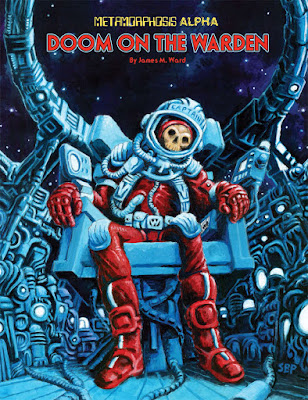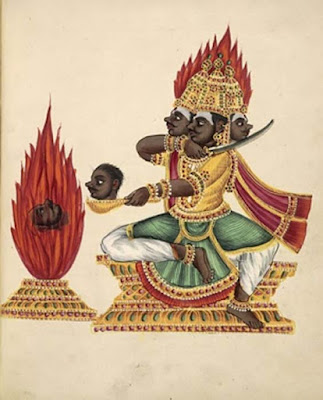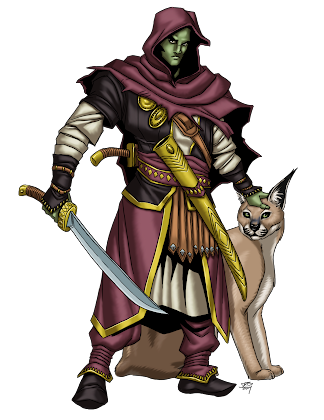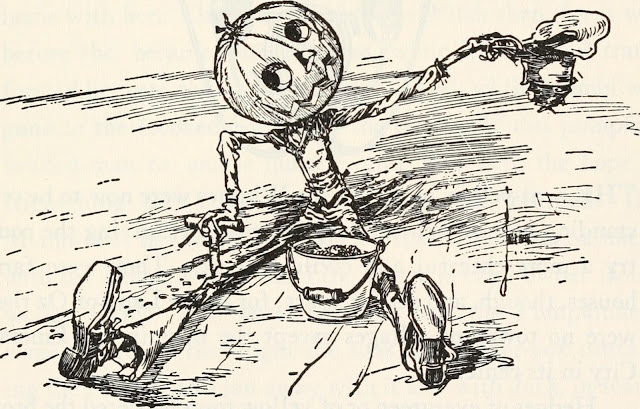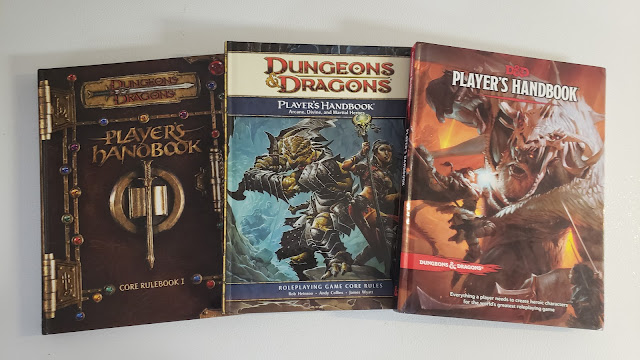Young Gods
 “Good evening, and once upon a time…” What if these were the opening words of the six o’clock news? What if the news was not only of the latest government initiative, a war in a faraway country, threat of famine in another, a new economic report, a celebrity’s scandalous activities, and all you would expect, but also of Gods walking the Earth, their cults proudly and joyously celebrating festivals dedicated to them, of myths being enacted and reinforced? What if corporations and celebrities and politicians purposefully align their brands with the Gods in the hope gaining their patronage, the love affairs and scandals of the Gods are the subject of the magazines at the supermarket checkout, Valkyries and Amazons work as mercenaries, Satyrs make for the greatest party hosts and revellers, and victorious sports teams give praise to Nike? And not millennia ago, but yesterday, last week, and tomorrow? This is The World, which is just like ours except that the Gods are real, their faiths accepted alongside the more modern monotheistic faiths of ours, and the supernatural is real, but occluded rather than hidden.
“Good evening, and once upon a time…” What if these were the opening words of the six o’clock news? What if the news was not only of the latest government initiative, a war in a faraway country, threat of famine in another, a new economic report, a celebrity’s scandalous activities, and all you would expect, but also of Gods walking the Earth, their cults proudly and joyously celebrating festivals dedicated to them, of myths being enacted and reinforced? What if corporations and celebrities and politicians purposefully align their brands with the Gods in the hope gaining their patronage, the love affairs and scandals of the Gods are the subject of the magazines at the supermarket checkout, Valkyries and Amazons work as mercenaries, Satyrs make for the greatest party hosts and revellers, and victorious sports teams give praise to Nike? And not millennia ago, but yesterday, last week, and tomorrow? This is The World, which is just like ours except that the Gods are real, their faiths accepted alongside the more modern monotheistic faiths of ours, and the supernatural is real, but occluded rather than hidden.The World is one with multiple pantheons—the Aesir, Manitou, Theoi, Netjer, Kami, Tuatha Dé Danann, Óríshá, Devá, Shén, and Teōtl pantheons—often rivals and competitors for the same myths, legends, artefacts, and aspects of The World. As much as they are idolised, it is rare for any one of the Gods to walk the Earth or directly intervene in the affairs of mortals, primarily because they need to maintain a balance between the human belief and worship in them which forms both their personalities and their roles and the danger that the fickle nature of that belief and worship will drastically change their personalities and their roles. Instead, they reside in Overworlds and Underworlds from which they project Terra Incognita, lands of myth once removed from The World, but accessed via Gates such as Bifrost or Fengdu Ghost City, or Axes Mundi, like travelling the aether or sailing the ocean to reach the River Styx. Many of these Terra Incognita parallel real-world locations in The World. For example, Boston’s Catholic churches double as Tuatha sancta, whilst its city parks are strewn with fairy mounds from which lead stray paths where tolls must be paid or riddles answered to again access dreamlike gardens. Sailors carrying a piece of wood or stone from Ireland may find themselves voyaging into Tir na nÓg rather than docking in Boston Harbour. The shining metropolis of Memphis in Egypt with its skyscrapers and maglev mass transit is contrasted with the ancient and macabre necropolis of Saqqara next door, where with the right spells, entry into the Duat, the realm of the dead, may be found.
The feuds and rivalries between the Gods are not the only sources of conflict in The World. The primary conflict is between the Gods and the Titans. The Titans are also deities, but are archetypal embodiments of a particular purview whose pursuit of their primal urges tend to have destructive effects, especially on the mortal realms. Consequently, the Gods, many of them children of the Titans, imprisoned the Titans, who have rattled their chains ever since, more recently weakening them and allowing their more monstrous offspring to enter The World and threaten humanity. Into this conflict step the Scions. Each is the half-divine child of one the Gods and humanity. Many do not know the true nature of their parentage and so explain their amazing abilities and skills as being due natural talents, others have undergone the Visitation, the moment when their true nature and divine lineage is revealed and they are granted their Birthright, gifts from their godly parent.
This is the set-up for Scion: Second Edition, published by Onyx Path Publishing. Inspired by The Wicked + The Divine by Keiron Gillen and Jamie McKelvie, Roger Zelazny’s Lord of Light, American Gods by Neil Gaiman, the television series Carnivàle, and others, this is a contemporary roleplaying game of modern myth and epic heroism in which not only do the gods walk amongst us, they often have children too. These children, the Scions of the gods, born to the magic of yesterday and the promise of tomorrow, are caught up in a war with the Titans, elder beings who rage against the human world and its wayward gods. As children of the gods, the Player Characters protect the interests of their parents on Earth whilst protecting humanity against the ravages of the Titans. It is explored through not one book, but four, each book representing a different Tier. These are Scion: Origin, Scion: Hero, Scion: Demi-God, and Scion: God, which explore the Scions’ growing ties to their own myths and legends and to the mortal world, the latter weakening as the former strengthens, as they become increasingly involved in divine conflicts.
Scion: Origin is the starting point. The Player Characters are mortals, not yet aware of their true nature, even though divine ichor flows through their veins. They might be a faith healer whose powers are truly divine in nature, a stuntman whose physical prowess enables him to throw himself into any situation, a gambler whose luck truly shines, a mercenary for hire always able to get the job done, but part of that will be their unknown divine mature. Alternatively, a Scion may not be the son or daughter of a God, but a Supernatural being. These include Saints, Kitsune, Satyrs, Therianthropes, Wolf-Warriors, and Cu Sith, who may in turn achieve true divinity like the sons and daughters of the Gods.
A Player Character in Scion: Origin is first defined by a Concept and three Deeds—short-term, long term, and band-term—which combine the Scion’s aims and what his player wants. He has three Paths, one each connected to his Origin, Role, and Society/Pantheon, representing decisions the Scion has made or experiences made, the Origin his background, the Role his occupation or area of expertise, and Society/Pantheon his connection to an organisation, cult, or pantheon. Origin Paths include Adventurer, Life of Privilege, Military Brat, or Child of the Street; Role Paths include Charismatic Leader, Detective, and Technology Expert; and Society/Pantheon the Aesir, Manitou, Theoi, Netjer, Kami, Tuatha Dé Danann, Óríshá, Devá, Shén, and Teōtl pantheons and one of its Gods. In the long term, a Path also provides a route along which a player can develop his character, and will be rewarded in doing so with slightly reduced Experience Point costs. He also has Skills and Attributes, and lastly, a Calling and Knacks. The Calling is an archetype such as Creator, Guardian, Hunter, Lover, and so on, each of which has several associated natural or supernatural benefits, or Knacks. For example, ‘The Bare Minimum’ for the Healer Calling, enables a Scion to tend someone safely even without the right tools and ‘Experienced Traveler’ for the Liminal Calling lets a Scion quickly pick up social cues and language even in the remotest of locations, and is unlikely to be seen as out of place. Some Knacks require the expenditure of Momentum—acquired from failed dice rolls, and whilst a Scion can know multiple Knacks, at the Tier of Scion: Origin, he can only have the one active.
Creating a Scion is a matter of making choices building upon the Concept and selected Pantheon, the player deciding which of his Scion’s Paths is primary, secondary, and tertiary and assigning dots to skills based on each Path’s skills. Attributes are divided into three arenas—mental, physical, social, and are assigned dots based whether they are primary, secondary, or tertiary. The Scion’s Approach, how he prefers to act, whether through Force, Finesse, or Resilience, grants further dots in the three associated attributes. The process is not complex, and whilst it is supported by a solid example, it could have been eased with a clearer summary at the start of the process.
Our sample Scion is the Pre-Visitation Elias Castro who made it big as a successful lawyer defending even bigger-name clients, some of whom were guilty and he managed to get off. He made himself rich and famous—even infamous—and then his conscience got to him. Elias began to drink and gamble, putting himself in debt, leading to a vicious circle of terrible clients, drinking, and gambling. Part of him wants to be off the rollercoaster, part of him continues to enjoy the ride.
Name: Elias Castro
Concept: Off-the-deep-end Gambler
Parent: Hermes
Origin Path: Surburbia – Everybody’s gotta grow up somewhere
Role Path: Charismatic Leader – Honey tongued lawyer
Pantheon Path: Hermes – Caught between two worlds
Calling: Trickster (1)
DEEDS
Short-Term Deed: To take one more risk (Courage)
Long-Term Deed: To get sober (Conviction)
Band-Term Deed:
SKILLS
Culture 3 (Rough & the Smooth), Empathy 5 (I can see through you), Integrity 3 (I stand by everything I say), Leadership 2, Persuasion 5 (Would I lie to you?), Subterfuge 4 (God of Gamblers), Technology 1
ATTRIBUTES
Intellect 3 Might 1 Presence 3
Cunning* 4 Dexterity* 2 Manipulation* 5
Resolve 2 Stamina 1 Composure 3
Movement: 2
Defence: 1
KNACKS
Aura of Greatness, Rumour Miller, Wasn’t Me
Mechanically, Scion: Origin employs the Storypath system, which can be best described as a distillation of the Storyteller system—the mechanics of which date all of the way back to Vampire: The Masquerade—and certainly anyone familiar with the Storyteller system will find that it has a lot in common with the Storypath system, except that the Storypath system is simpler and streamlined, designed for slightly cinematic, effect driven play. The core mechanic uses dice pools of ten-sided dice, typically formed from the combination of a skill and an attribute, for example Pilot and Dexterity to fly a helicopter, Survival and Stamina to cross a wilderness, and Persuasion and Manipulation to unobtrusively get someone to do what a character wants. These skill and attribute combinations are designed to be flexible, the aim being any situation is to score one or more Successes, a Success being a result of eight or more (this can be lowered as Scions become more powerful). Rolls of ten are added to the total and a player can roll them again.
To succeed, a player needs to roll at least one Success, and may need to roll more depending upon the Difficulty of the task. Should a Scion succeed, he can increase the number of Successes with an Enhancement, such as having a fast car in a race or the favour of a particular God, but he needs to succeed in order to use the Enhancement. Any Successes generated beyond the Difficulty become Threshold Success and represent how well the character has succeeded. These can be spent by the player to buy off Complications, for example, not attracting the attention of the Police in a car chase, or to purchase Stunts. These can cost nothing, for example, the Inflict Damage Stunt, whereas the Disarm Stunt costs two and the Critical Hit Stunt costs four. Characters in Scion: Second Edition often have Stunts due to their Birthright, such as Loki, which grants the ability to positively influence someone, but only when the character lies, but Birthrights are outside the scope of Scion: Origin.
Under the Storypath system, and thus in Scion: Origin, failure is never complete. Rather, if a player does not roll any Successes, then he receives a Consolation. This can be a ‘Twist of Fate’, which reveals an alternative approach or new information; a ‘Chance Meeting’ introduces a new helpful NPC; or an ‘Unlooked-for Advantage’, an Enhancement which can be used in a future challenge. Alternatively, a character gains Momentum which goes into a collective pot and which can be spent to add extra dice to a dice pool or used to fuel various Knacks possessed by the Scions. Scion: Origin focuses on three areas of action—Action-Adventure, Procedurals, and Intrigue. The first covers combat and is fairly straightforward. The second handles information gathering, which is divided into two categories. Leads start or continue the plot and so do not have to be rolled for by the players, whereas Clues provide extra information, are more challenging to find, and do require a roll. Intrigue covers social interaction and the reading and shifting of the attitudes of both NPCs and player characters.
Scion: Origin is a roleplaying game of supernatural and divine beings, many of varying power and scope. The mechanics cover this with Scale, both Narrative and Dramatic. Narrative Scale covers minor characters and story elements, whilst Dramatic Scale covers situations when it applies to the Player Characters. When Scale comes into play, it adds a number of Enhancements equal to the difference between the two sides involved in the scene. As with the rest of the Storypath system, Enhancements come into play as effects if successes are generated as part of a test.
The advice for Storyguide includes the general and the specific. The general is the fairly standard and includes ignoring or modifying rules she does not like, ensuring that everyone around the table is comfortable with the tone and content of the game being played, and so on. This does feel underwritten and could have included further advice and safety tools such as the X-Card. The specific discusses how to set up a campaign through steps of what it calls the Plot Engine—the seed, the pitch, and deeds and arcs. Naturally, it emphasis how to bring the myth into the game, but keep it subtle because the Scions are not truly divine, so will not be enacting the Saga of Argonauts, the search for the Golden Fleece, or penetrating the maze of the Minotaur—at least not literally. Instead, they might be enacting them with the myth alluded to, but underlying the mundane. So at the Myth Level of Scion: Origin, set at Iron Level—with the divine present in the mundane world as signs and omens which may or may not be real, bordering on Heroic Level—in which the supernatural has begun to become apparent, the search for the Golden Fleece might turn into a road trip to get a fleece jacket back , whilst penetrating the maze might mean a bureaucracy rather a labyrinth. This can be as subtle or not as the story warrants, the Storyguide advised to play with and enforce mythic tropes such as the Rule of Three, Hometown Advantage, Beauty is Only Skin Deep, and so on. To do this, the Storyguide will need to research and adapt myth upon myth, and depending upon the choices made by her players, the mythos of pantheons she is not familiar with. She is also advised to keep it dramatic, including repeating a call to adventure over and over if a Scion ignores it, slightly changing the nature of the call each time. This is delightfully unsubtle and whilst you might not do it in another roleplaying game, it is perfectly in keeping with the Urban Fantasy genre and thus Scion: Origin.
The setting to Scion: Origin is explored in several ways. This includes several pieces of fiction, all by Kieron Gillen—author of The Wicked + Divine—telling the story of Scion discovering the true nature of the world around and her place in it. Along with the sample pre-generated Scions, these a holdover from the roleplaying game’s first edition, they bring a personal perspective to the setting. One of these examples includes a God not given in the list pantheons to show other deities can be included. As well as exploring the nature of The World and its differences with ours, several cities are described, including their links to the Terra Incognito and the Axis Mundi. They include Boston and New York, Kyoto and Memphis, Mexico City and Varanasi, and more. Not all in the same detail, but they do suggest how other cities might be explored in a similar fashion. There is also a good chapter of antagonists, including archetypes, using qualities, flairs (one-shot abilities which require a cool-down period to use again), and utilities to build important NPCs, advice on creating them, and numerous ready-to-play examples. The latter are accompanied by design notes which explore the principles of each mythic creature, suggesting how they can be used and adapted from one pantheon to another.
Rounding out Scion: Origin is a set of appendices. The first explores six Supernatural Paths. These include Saints, Kitsune, Satyrs, Therianthropes, Wolf-Warriors, and Cu Sith. Of these, Therianthropes are lycanthropes, Wolf-Warriors are berserkers, and Cu Sith are fey canines. Guidelines are given on how to adjust them to model other mythical figures, such as adapting the Wolf-Warrior to be a classical Amazon, a Dahomey Amazon, and a Shieldmaiden. These shift Scion: Origin away from being a roleplaying game about the divine, and more to encompass the Urban Fantasy genre, as well as pleasingly demonstrating the flexibility of these archetypes. That said, more of them included in the book would have been nice. The second lists all of the major Gods and their Callings and Purviews for all ten pantheons presented in Scion: Origin. They include the Aesir or Norse Gods, the Manitou or Algonquian pantheon, the Theoi or Greco-Roman pantheon, Netjer or Egyptian pantheon, the Kami or Japanese Gods, the Tuatha Dé Danann or Irish Gods, the Óríshá or Yórúba pantheon, the Devá or Gods of South Asia, the Shén or Chinese pantheon, and Teōtl or Aztec pantheon. These are lists only, and whilst useful, further research upon the part of the Storyguide and her players will be needed beyond this. The third and last appendix provides a conversion guide from the first edition to the second edition of Scion: Origin.
Physically, Scion: Origin is well-written, the full colour artwork throughout is excellent, and the whole affair is attractive. Perhaps in places it feels a little too concise, especially in the examples of the rules. What Scion: Origin is lacking though, is a beginning scenario, which would suggest some idea as to how the designers intend the roleplaying game to be played. However, there is the quick-start for it, A Light Extinguished: A Jumpstart For Scion Second Edition, which could be played with the full rules using Scions of the players’ own design, rather than the pre-generated ones provided in the quick-start. More of a problem is the lack of story hooks or campaign suggestions which might have helped spur the Storyguide’s imagination. Similarly, it would have been interesting to see myths taken from the different pantheons and worked through to see how they could work in Scion: Origin. Doing so would also have been a chance for the designers to showcase some of the less familiar pantheons. Elsewhere an example of play and a full example of combat would both have been helpful.
Scion: Origin is a roleplaying game about playing Gods to be, so it is almost as if Scion: Origin is wanting to pull the Scions onto the step in their Paths to divinity, which technically would be Scion: Hero, but it never goes as far as pulling the setting of The World and the Scions over that threshold. There is a sense of the liminal to Scion: Origin which is not helped by the lack of examples and the Storyguide being left to research, adapt, and develop myths of the pantheons to really get started. This is not to say that the tools are not there for the Storyguide to get started—the Storypath system is suitably cinematic, the advice is solid, and the background is good, but Scion: Origin does not help the Storyguide make that first step into The World easy. However, Scion: Origin is a roleplaying game full of great potential and a roleplaying game in which the Player Characters are also full of great potential. For the Storyguide willing to work myths, Scion: Origin will turn into some potentially mythic stories and adventures.
